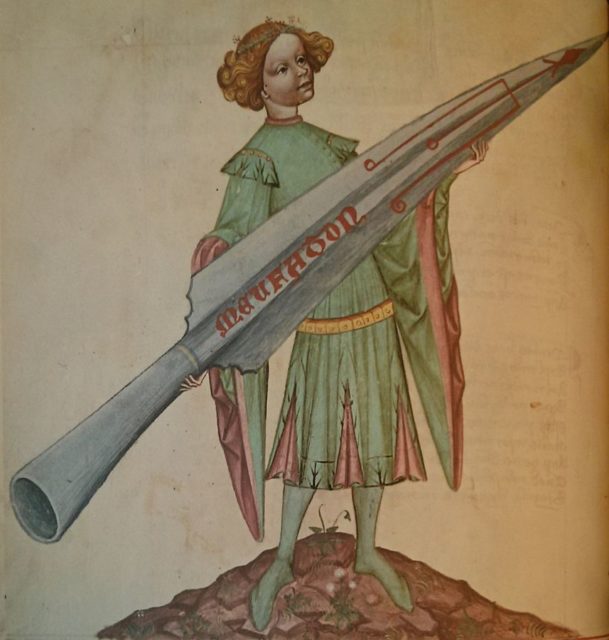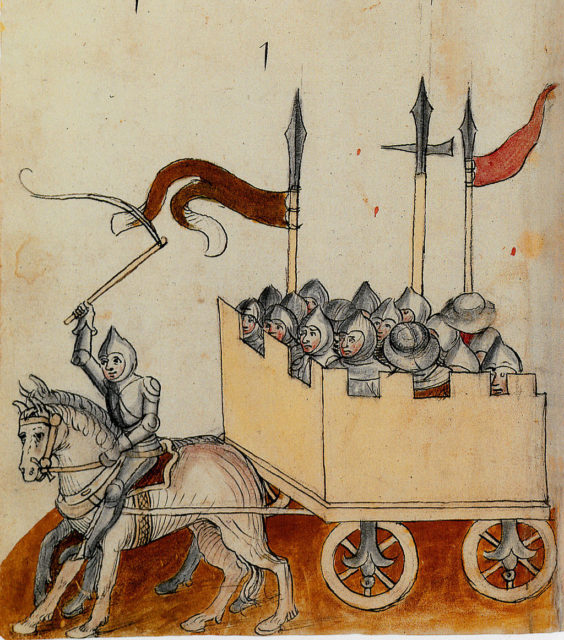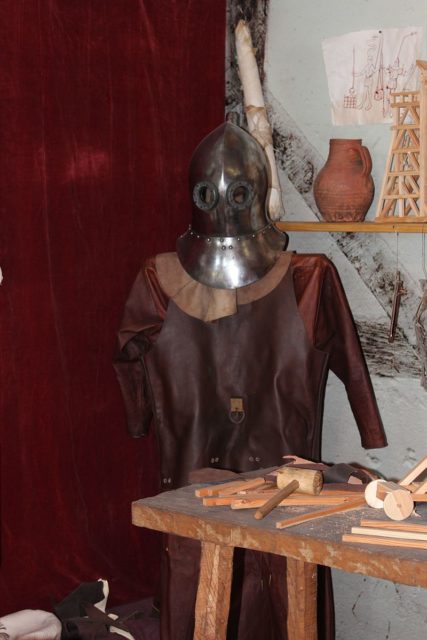First published in 1405, Conrad Kyeser’s book Bellifortis was a guide to war at a turning point. He sought to shift the focus from chivalry onto technical achievements. Full of designs for war machines – some practical and others wildly fanciful – his work has been compared with the military designs of Leonardo da Vinci.
It was a book that would be quoted and imitated for centuries. For all its importance, however, it showed how hard it was to introduce new ideas to the medieval military.
A Man of Mystery
We do not have a clear picture of who Conrad Kyeser was. Either a captain or a physician, he was certainly a military veteran with a fine technical mind.
Kyeser was probably present at the Battle of Nicopolis when the last major crusade was soundly crushed. Outraged by this disaster and fleeing political problems, he returned to his native Eichstätt. In 1402 he began work on the Bellifortis. It was his chance to show how a war should be fought.

The Changing View of Warfare
Warfare was changing in early 15th century Europe. Missile weapons were becoming more powerful, in the form both of better bows and of gunpowder technology. Professional mercenaries were increasingly important, particularly in Italy where they went by the title of condottiere.
These ways of warfare emphasized specialist skills and knowledge. Professionals saw technical expertise replacing traditional chivalric values, although the aristocracy disagreed.
Professionalism and Paper
The rise of the professional was accompanied by the rise of the technical manual.
Books on war were increasingly popular among those wealthy enough to be able to purchase them. They ranged from Geoffroi de Charny’s Book of Chivalry through books of tournament rules to passages from classical works like Vegetius’ De Re Militari.
Men such as Kyeser and the Italian fighting master Fiore dei Liberi wrote books for this market. As well as sources of income, they were meant to show off the authors’ skills and so attract wealthy patrons.

Illuminating Illuminations
One of the appeals of Kyeser’s work was the illustrations. He acquired two skilled illustrators to help him demonstrate the points he was making. Others copied their images and provided insights into Kyeser’s thinking and warfare at the time.
Some of these illustrations give us realistic examples of late medieval armor, early gunpowder weapons, and the construction of siege machines. Others show the wild fancies of an innovator caught up in his own imagination.
Turning to Technology
Bellifortis’ illustrations show Kyeser to be a man fascinated by the potential of technology. There are horse-drawn battle wagons, novel gun designs, and devices for prying open drawbridges. He uses technology for everything from greater firepower to fighting underwater.
Such a focus on technology was ground-breaking. Medieval thinkers preferred the reliability of precedent to the novelty of innovation. Success in a war was seen as coming from individual skill and courage, not the tools with which it was fought.
Siege Machines
Sieges were the main engineering focus of medieval warfare. Vast machines and mining operations were crucial to penetrating towns and castles. It is unsurprising that Kyeser shows many tools for winning sieges.
There are illustrations of a range of machines to bombard defenses, from rock-flinging trebuchets to bolt-throwers. Ropes and hooks to attach ladders to walls are shown. Innovative ideas include a hooked device for forcing down an enemy drawbridge.

On the Offensive
There are also machines designed for battlefield attacks. With these, Kyeser tackled the great military challenge of the day; the rise in power of infantry. Traditional heavy cavalry charges were becoming less effective due to the increase of defensive formations such as the spear-armed schiltrom and the longbow block. New ways were needed to break infantry formations.
Kyeser’s solutions included a human threshing machine similar to da Vinci’s more macabre designs. Powered by a human operator, its many blades were meant to slice through ranks of men like a scythe through corn. Whether or not Kyeser thought the device realistic, it was never seen in battle.
Guns, Grenades, and Tanks
In hindsight, Kyeser’s ideas for gunpowder are more realistic, although they may have looked just as fanciful at the time.
For guns, he considered the rate of fire and stability. Multi-barrelled machines were designed to allow multiple shots in quick succession. Defenses for gunners enabled them to reload without distraction in an era when reloading took at least a minute and left the gunner vulnerable to attack. To make guns more stable and accurate, he suggested platforms and supports.
One of Kyeser’s ideas was a mobile gun platform with an outer shell, a precursor to the principles of the modern tank. With its wooden walls, it would have been vulnerable to fire, but it offered a solution to the immobility of powerful gunpowder weapons.
Bombs and grenades, just coming into use, drew Kyeser’s attention. He provided suggestions for gunpowder production to ensure the power of gunpowder weapons.

War in the Water
The Battle of Nicopolis was shaped by the problem of crossing a river and this may be why many of Kyeser’s ideas involve water. There are bridging devices, pumps, and water wheels. Most fantastically, he suggested a suit for walking underwater.
He was providing logistical solutions as well as ideas for more efficient killing.
Appealing to Antiquity
Despite his inclination to innovation, Kyeser had to look to the past to legitimize his work. He did this by regularly citing the example of Alexander the Great, even suggesting that new ideas came from this ancient and respected monarch. The image of Alexander had clearly caught Kyeser’s attention and he hoped this would appeal to his audience too.
Kyeser had the mind of a great military innovator. However, as warfare changed he had to maintain the pretense of tradition to sell his work. Bellifortis was a military manual but it was also an advert, a pitch to those who might want to hire the mind behind it. The strange and macabre technical mind of Conrad Kyeser.
Source:
Brian R. Price (2016), “Bellifortis,” in Medieval Warfare Vol VI Issue 5.
